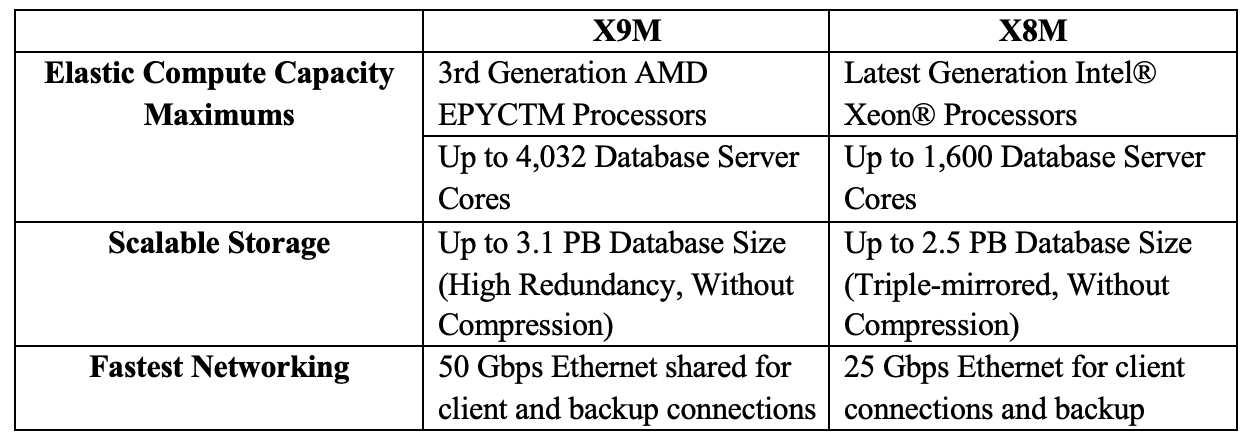On April 20, 2022, Oracle announced the availability of the next generation of the Exadata platform, the X9M, in Oracle Cloud Infrastructure making the world’s fastest cloud database platform even faster and more affordable. But what does this mean for Oracle Autonomous Database Dedicated users? In this blog, I’ll review key enhancements that come with the new Exadata Cloud Infrastructure X9M and how it benefits customers.
Oracle Autonomous Database on Dedicated Exadata Infrastructure
Let’s start with an overview of Oracle Autonomous Database (ADB). It is a self-driving, self-securing, self-repairing database that leverages AI and machine learning to make end-to-end database management simple. You get a minimum of 99.95% availability guaranteed so you can rest assured that your database is in continual operation with Oracle’s commitment to uptime and connectivity. Further, if you deploy Autonomous Data Guard, that availability SLA increases to 99.995%! This fully managed, fully tuned, and fully elastic high-performance solution includes Autonomous Data Warehouse, Autonomous JSON Database, Autonomous Transaction Processing, and APEX Application Development to best fit whatever workload you have. To learn more about the key features, please refer here.
Autonomous Database has two deployment choices in the public cloud: Dedicated Infrastructure (ADB-D) and Shared Infrastructure (ADB-S). For the purposes of this blog, we’ll focus on ADB-D, but to learn more about ADB-S, click here. ADB-D is a customizable private database cloud in the public cloud. It provides you the highest security, isolation, and governance levels. Besides having private use of this hardware, ADB-D offers the flexibility of the multitenant database architecture which lets you create and manage Autonomous Container Databases and provision multiple Autonomous Databases within those containers allowing you to group Autonomous Databases in whatever fashion you choose. This allows you to specify when maintenance occurs, which databases are patched, and in what order.
Feature Differentiators

With this X9M generation, you’re able to get 2.5x more database CPU cores which means higher consolidation on the same number of servers. Along with the increase in specs, there are new software enhancements to increase performance. We have improved Smart Scan performance for large complex queries, improved speed for both Firmware and Software updates, and added native support for Block Chain tables on Exadata. Plus, we’ve improved decryption and decompression algorithms so they can keep up with ultra-fast analytics workloads. Storage indexes and the columnar cache are now persisted so there is no longer a need to warm up your data after a reboot or a patching of a server. All these improvements come to you at no extra cost because the price from X8M to X9M remains unchanged. To learn more about the features of X9M, please refer to this data sheet.
Performance Comparison
The X8M was already the fastest Database Cloud platform, and X9M is even faster. For OLTP workloads, X9M provides over 87% more IO/sec: 22.4 million read IOPS with just 8 database servers while maintaining ultra-fast <19 microsecond IO latency. For Analytics workloads, the X9M increases Analytics Scan throughput by 80%, up to 2.8 TB/sec of scan rate. The performance increase you get with this new generation is unmatched for whatever workload you have, and it continues to scale when you add more servers.
Autonomous Database Dedicated Recent Enhancements
Along with all the enhancements that come from this new generation of Exadata, we have made multiple notable enhancements to ADB-D. You can now automatically failover to a Data Guard standby database without the need to even push a button. ADB-D also supports GoldenGate as either source or destination to support advanced data mesh architectures and extend your ADB-D to a 3rd site for mission critical architectures. Plus, you can bring your own keys to Autonomous Data Guard using Oracle Key Vault including cross-region key management and integration with Azure Active Directory using Azure OAuth2 tokens.
Our manageability improvements help you get a better handle on your ADB-D environment. We have integrated ADB-D into our Database Management Service so you can now manage Autonomous and Non-Autonomous databases from a single cloud console. We’ve added standard tagging to ADB-D resources so you can more easily track costs, support for resource usage tracking and new events for the Exadata VM Cluster and other ADB-D resources.
Prior to the X9M launch, you were only able to provision quarter racks, but now there is elastic provisioning. You can now provision a right-sized hardware configuration for all your workload needs.
And lastly, you can save more money with fractional OCPUs. Save costs for dev-test or small production database deployments by running as many as 10 databases on 1 core while capitalizing on Autonomous Databases Auto Scaling feature to increase compute power for those periods of time when additional capacity is needed.
Benefits
With ADB-D, you’re refocusing database management staff from keeping the lights on to innovation. They’re able to spend more time on creating greater business value instead of managing and tuning databases. This can mean anything from data modeling, assisting programmers with data and application architecture, application tuning, planning future capacity and many other activities that cut costs or otherwise give your company competitive advantage.
Now let’s discuss how the new X9M performance improvements translate into benefits for ADB-D customers. First and foremost, you’re getting better performance for your databases due to the higher IOPS, bandwidth, and more available cores. You’re now able to run a higher number of concurrent workloads without sacrificing performance which means you can now get more information from your data in less time and/or increase your overall transaction throughput. With this performance increase, the information supply chain is shortened enabling the business to act faster.
Imagine a query or business critical job that has a very tight SLA to close the books or make vendor payments completing in 33-50% less time than it takes now. Depending on the job, its parallelism and the amount of data and IO involved, with 2x the IO bandwidth, 25% more memory to process data and 25% more cores for increased parallelism on just a quarter rack, these kinds of improvements are possible! This increases the overall value of your enterprise data capital since you’re able to process more data, run more reports in less elapsed time, harvest more information from the same data and just do more overall. Now you’re able to stay one step ahead of the competition with faster business decisions and a more agile business model. And since there is no price change with the next generation Exadata, you’re able to run higher consolidation levels on less hardware resulting in substantial cost savings to you. ADB-D on OCI provides low-cost subscription pricing. You only pay for what you use so you can take advantage of online resource scaling, fractional OCPUs, and the ability to set consumption to zero when not in use for additional savings.
I’ve only given you the highlights! For even more details on the capabilities and benefits of Oracle Autonomous Database on Dedicated Exadata Infrastructure, click here.
Get Started Today
See first-hand how Oracle Autonomous Database eliminates the complexity of operating and securing Oracle Databases while giving customers the highest levels of performance, scalability, and availability. Try out ADB-D yourself with Oracle LiveLabs, a free of charge service where you can learn technical skills without creating an account or Oracle Cloud tenancy, and once you feel ready to explore Oracle Cloud Infrastructure, get unlimited services like Autonomous Database with the Always Free Tier.
